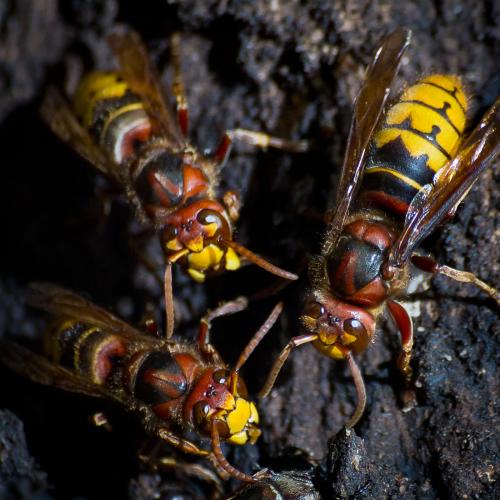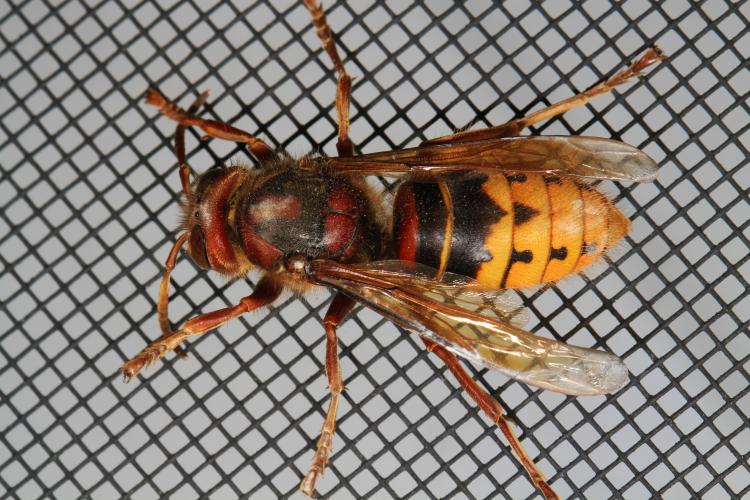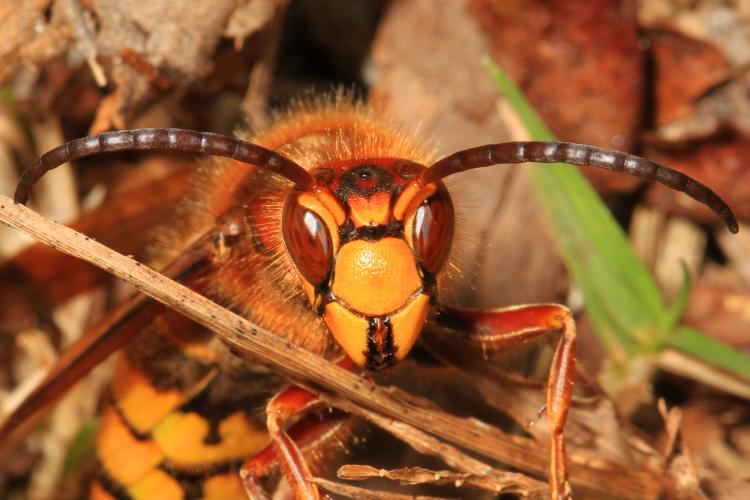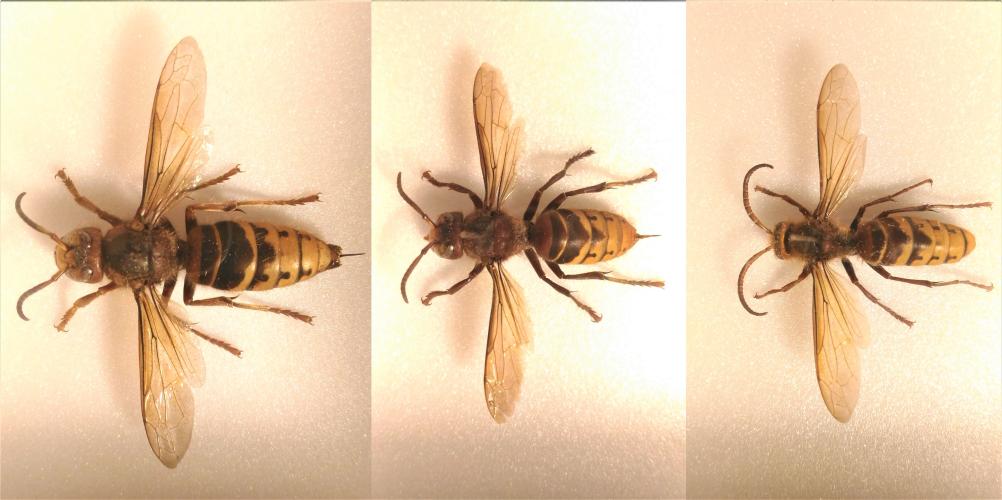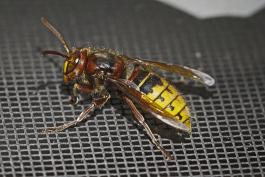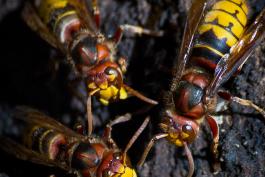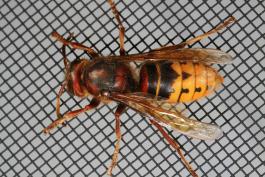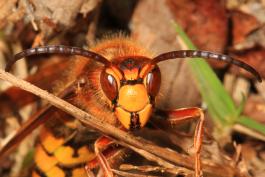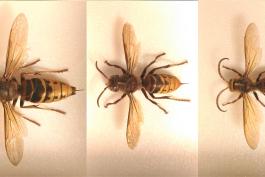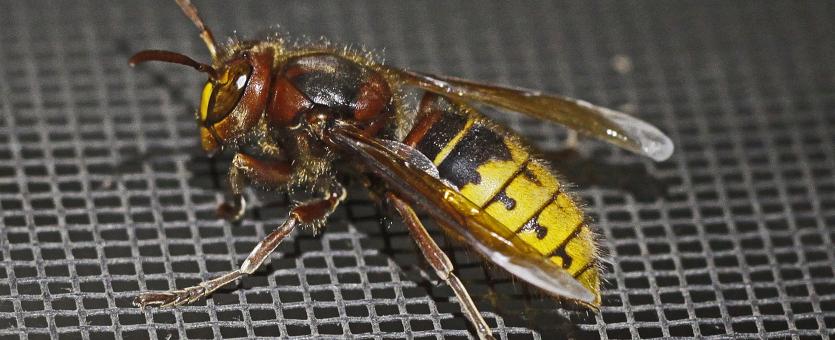
In Missouri, European hornets are distinguished from other large black, brown, and yellow wasps by their large size and by the presence of reddish-brown color on the thorax and on the first segment of the abdomen. Also, at first glance, you’ll notice that the hind portion of the abdomen is mainly yellow while the front of the abdomen is dark. Note that the narrow black bands on the abdomen have knobby or teardrop-shaped markings (or dots) extending into the yellow bands. The head is rust-colored, but the front of the face is yellow. Each eye is basically C-shaped. A closer look shows that the thorax and abdomen are somewhat hairy.
Similar species: Missouri has several wasps that could be confused with the European hornet.
- Two remarkably large native Missouri wasps look most similar: the eastern cicada-killer wasp and the eastern stizus (Sphecius speciosus and Stizus brevipennis). Though quite large, their colorations and patterns are quite different from the European hornet. Also, the cicada-killer and the stizus are solitary wasps: each individual female builds a tunnel in the soil for her paralyzed prey and her eggs. They don’t live in colonies or build paper nests the way European hornets do.
- The bald-faced hornet (Dolichovespula maculata), like the European hornet, lives in colonies and builds large, paper nests, but these round nests usually hang in trees, not in dark, sheltered, hollow places like the spaces between walls. Also, bald-faced hornets are smaller and are mostly black with some whitish markings, so their bodies look much different.
- Yellowjackets (genus Vespula), while also yellow-and-black striped, are a lot smaller, about the size of honeybees. They live in colonies and build paper nests, but these paper nests are in a burrow, underground, rarely seen by people. Yellowjackets are the hornets that you might see busily flying in and out of their hole in the ground, and the ones infamous for visiting soda cans in late summer.
Finally, people may confuse the European hornet with the highly publicized Asian giant hornet (AGH), also called northern giant hornet or Japanese giant wasp (Vespa mandarinia). The AGH has not been found in Missouri, but it is the species that went viral on social media as the so-called murder hornet. The AGH was discovered in British Columbia and in Washington state, sporadically, in 2019–2021. All introductions of the AGH appear to have been eradicated. The AGH, considered invasive if it becomes established, has not been found anywhere in eastern North America, and it has not been found in Missouri. It’s the world’s largest hornet. The bodies of queens (rarely seen) may exceed 2 inches in length; the workers’ bodies may be 1½ inches long. This species attacks and destroys (“murders”) honeybee colonies. If this species becomes established, it will negatively affect the environment, agriculture, and the economy. In North America, unless you are in the US Pacific Northwest or in southwestern Canada, you are extremely unlikely to see an Asian giant hornet.
Length (not including appendages): to 1 inch (workers); 1 to 1⅜ inches (queens).
Statewide.
Habitat and Conservation
This species constructs paper nests from chewed-up wood particles mixed with saliva. The interior of the nest is filled with paper (not wax) honeycomb; the outside is covered with successive layered pockets of paper, resulting in an overall rounded shape. They naturally build their nests high up inside hollow trees, but they may also build them in similarly hollow, dark human-built structures, such as barns, sheds, outhouses, attics, sheltered eaves, and empty spaces between walls in homes.
Because they typically build nests in hollow trees, using chewed-up wood to create the paper walls and chambers of their nests, they are most likely to be present in wooded areas, or areas with plenty of mature trees.
This species is sometimes attracted to lights at night.
Food
Like other hornets, this species hunts insects, which they feed to their larvae. Being rather large wasps, European hornets can capture relatively large prey, such as beetles, big moths, dragonflies, mantises, and cicadas. They sometimes steal captured insects from spider webs.
Adults sustain themselves by drinking sweet juices from ripe, fallen fruits and by drinking sap. They may even drink the “honeydew” that is excreted by aphids and scale insects. Because aphids and scales suck sap from plants, they excrete a sugary liquid.
European hornets frequently obtain sap by chewing the bark from tree twigs, often girdling the twigs in the process. (Girdling means that they remove the bark from an entire ring around the twig, which usually results in the death of the twig above the “girdle,” since the bark injury prevents sap from flowing to the outer portion of the twig). Lilac seems to be a favorite plant for this behavior.
Adults may also drink from hummingbird feeders or forage from human garbage and picnic areas, especially in late summer and fall.
Status
Nonnative wasp introduced to eastern North America in the 1800s. Native to Eurasia, ranging from the British Isles to Japan.
Capable of stinging if mishandled. Except for individuals who are allergic to bee and wasp venom, the sting is not usually considered medically serious.
This is a eusocial wasp, forming colonies of related individuals, so they are defensive around their nest. Like other colony-forming wasps, European hornets may sting if you approach their nest too closely. Further from the nest, individuals are much less likely to sting a person, unless mishandled.
Taxonomy: Some scientists have described several subspecies, but today most scientists consider those to be only regional color variations, not worthy of taxonomic ranking.
Life Cycle
In spring, an overwintering queen hornet starts to construct a new nest and begins laying eggs for workers. After raising about 5–10 workers, the queen specializes in egg-laying, and her workers take over the duties of nest construction and maintenance, foraging outside the nest, and feeding the larvae. The workers are all non-reproductive females.
Colonies and nests reach their maximum size in late summer. Most nests only contain a maximum of about 400 workers, though there could potentially be up to 1,000. Around the middle of September, shortly before dying, the queen lays eggs that develop into males and into queens. The males and queens leave the nest and mate. The males die soon after, and the fertilized queens begin looking for sheltered places to hibernate during the winter. Like several other familiar wasps, they might enter houses and attics in fall, though they naturally would hide under loose tree bark or in other protected places.
What happens to the colony? As with our native bald-faced hornets, the workers die when the temperatures freeze. The colony is finished. The nests are not reused.
Human Connections
The European hornet is one of many nonnative insects have been introduced to North America from Eurasia. This species was introduced to New York around 1840 and has been spreading west and south.
The sting is not considered medically dangerous to people, but persons who are allergic to bee or wasp venom may have a life-threatening anaphylactic reaction if stung. It’s good to know the signs of anaphylactic shock, because exposure to a variety of substances (such as peanut butter, shellfish, medications, and more) may trigger certain people who are at risk for anaphylaxis.
If these or other hornets have built a nest in a place that is too close to people, consult a licensed exterminator, or just wait until a hard freeze puts an end to the colony. Eliminate things that might attract them, such as fallen ripe fruit, food trash, or dusk-to-dawn porchlights. To prevent them from living within your walls or attic, seal up cracks in your siding, roofing, and soffits, around windows and pipes, and anyplace else they might get in. If they are already living within a wall of a home, consult an exterminator. Plugging their outside entrance, once a colony is established, may force them to chew through interior walls and fly around inside your home.
Helpful or harmful? Unlike the infamous Asian giant hornet (which, again, does not occur in Missouri), the European hornet does not appear to be invasive. Also, although European hornets may prey on individual honeybees, plus many other kinds of insects, they do not destroy entire honeybee colonies the way the AGH does.
In some parts of Europe, where European hornets are native, their populations are declining because of persecution by fearful humans. In some places, their numbers have declined so much that they have gained legal protection. For example, in Germany, killing this species, or destroying its nests, has been illegal since 1987.
Ecosystem Connections
Like other nonnative, introduced insects, the role of European hornets in North American ecosystems is unnecessary at best. They hunt a wide variety of insects and are eaten by a variety of predators that are capable of eating wasps. Fortunately, this species seems to not have invasive tendencies.
As with other bees and wasps, only the females (workers and the queen) are capable of stinging. The stinger evolved from a harmless organ called the ovipositor, which many kinds of female insects use to deposit eggs. You’ve probably seen the ovipositor projecting like a needle from the hind end of a mature female cricket.
European hornets and other eusocial insects, such as yellowjackets, paper wasps, honeybees, and ants, have been called “superorganisms” by biologists. This means that the division of labor — foraging, nest building, feeding the young, mating and laying eggs, and so on — is so highly specialized within a colony that any individual doesn’t survive long on its own. Even the queen requires her colony of daughter-workers in order to survive and reproduce. Thus the colony, as a whole, is what lives and reproduces, as a superorganism.
In Eurasia, where the European hornet is native, there is a species of rove beetle, Velleius dilatatus, which lives in the nests of European hornets. It appears not to harm or benefit the hornets, but the rove beetles eat larval insects developing within the detritus that accumulates in active hornet nests. A European hornet nest may be a home for up to about 10 of these rove beetles.

